Ecommerce booms. Years of brick-and-mortar meltdown gets compressed into a few months.
By Wolf Richter for WOLF STREET.
Just how hard it is to even track the sudden collapse of brick-and-mortar retail sales when many stores are temporarily shut down and when the Census Bureau was operating at reduced capacity, was made clear in a special note when the Census Bureau released its report on retail sales today. The store locations across the US are normally contacted in various ways, including by email, regular mail, and phone calls. But this time, most of it was shifted to email and online. Stores that reported $0 sales were “tabulated with $0 sales as long as the company was viewed to be representative of other companies in the same industry.”
The hot and the near-dead all averaged out:
Total retail sales – which averages out the segments where sales soared and segments where sales collapsed to near zero, and we’ll get to them in a moment – plunged 16.4% in April from March after having already plunged 8.3% in March from February, to $404 billion, seasonally adjusted. This was down 21.6% from April last year. It was the lowest total since September 2012:
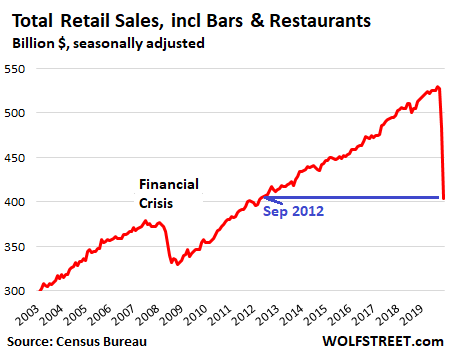
Where sales were hot — or at least not plunging.
Sales at grocery stores and beverage stores had spiked in March by 28% year-over-year to $82 billion after consumption shifted from restaurants, offices, and hotels to households. This was peppered with bouts of panic buying, hoarding, and contemplating empty shelves. But in April, these dynamics settled down somewhat.
Sales at these stores dropped 13% in April from March, to $71 billion, but were still up an astounding 12% from April last year – “astounding” because the grocery and beverage business is marked by persistent slow growth that is a function of population growth and price increases. That’s why grocery and beverage stores are considered “recession proof” – note the barely perceptible down-tick during the Financial Crisis. People will always buy food though they might skip other purchases. But what happened in March and April shows to what extent consumption suddenly shifted:
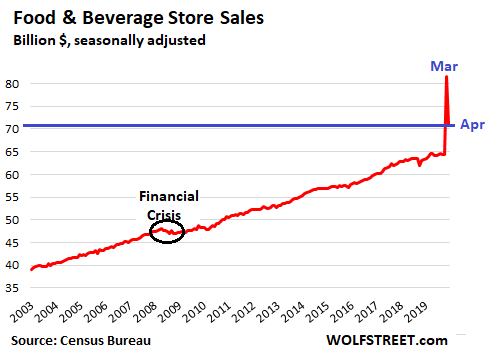
Sales at non-store retailers soared. This category overlaps partially with ecommerce but includes catalogue and mail-order operations, door-to-door sales, sales at temporary stalls and at vending machines. Powered by the boom in ecommerce – no matter how the other segments in this category fared – sales jumped by 8.4% in April from March and by 21.6% from April last year, to $78 billion:
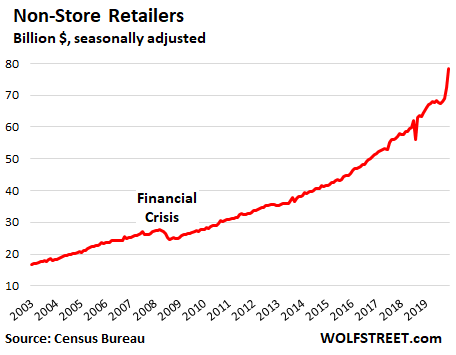
Sales at building materials, garden supply and equipment stores (includes hardware stores and stores like Home Depot) fell 3.5% in April from March, to $32 billion, but was still up 0.4% from April last year. As lousy as this is, in the current environment, it’s a huge accomplishment:
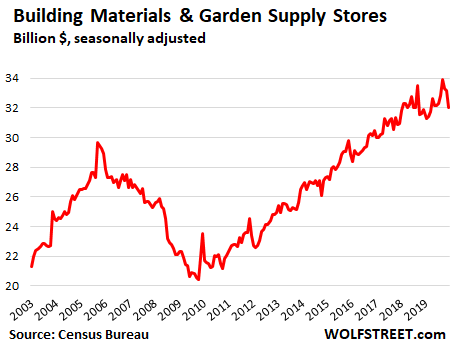
As for the rest, it was between ugly and beyond ugly.
Sales at general merchandise stores without department stores (Walmart and Costco are in this category) had spiked in March on panic buying and in April fell 19.5% from March to $45 billion, giving up all the March gains plus some, and were down 7.3% from a year ago. Department stores are in this category, but they’re special, they’re approaching the end of their life cycle for other reasons, so I removed them and displayed them separately further down.
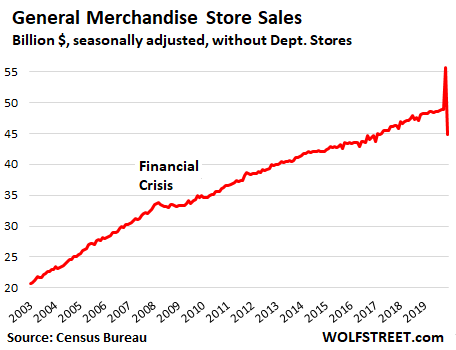
Brick-and-mortar department stores turned into zombies. Sales at department stores have been declining since their peak in 2001. Many iconic stores, including Sears and Bon Ton, have been dismembered in bankruptcy court. Luxury department store Neiman Marcus filed for bankruptcy last week. JCPenney will file for bankruptcy shortly. Lord & Taylor is planning to liquidate all its stores. Other department stores, including the largest surviving one, Macy’s, have announced wave after wave of store closings – for years.
Brick-and-mortar department stores were zombies long before Covid-19 appeared on the scene. Now the process is compressing the structural shift from many years into a few months. But Macy’s, Nordstrom, and others with a strong online brand can thrive as ecommerce retailers if they don’t screw it up by expense-cutting their online operations into ruin.
Before Covid-19 came along, department store sales had collapsed by 45% from $20 billion a month at the peak in 2001 to 11 billion a month earlier this year, despite two decades of inflation and population growth. Then in March, sales collapsed 24% from February, and in April sales collapsed another 29% from March, to just $6 billion:
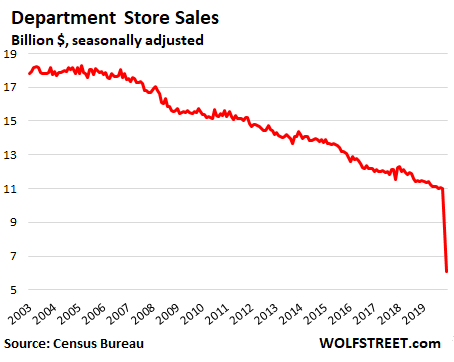
Sales at clothing & accessory stores fell to near-zero. Sales at brick-and-mortar stores had been stagnating for two years. They were shifting to ecommerce though many pundits had said that people would never buy clothes online. Then in March sales collapsed and in April collapsed further. Over the two-month period, sales have collapsed by 90% to just $2 billion:
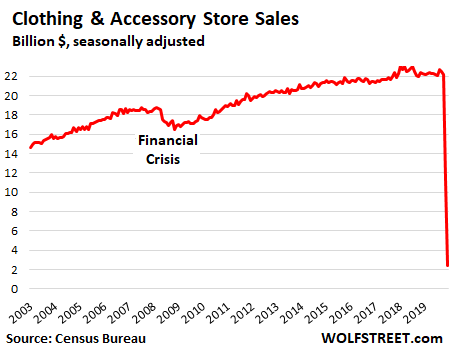
Sales at new & used vehicle dealers and at parts stores plunged 13.6% in April from March and 33.5% from April last year to $69 billion, a number first seen in February 2000 – a yes, back to the good old day of Y2K:
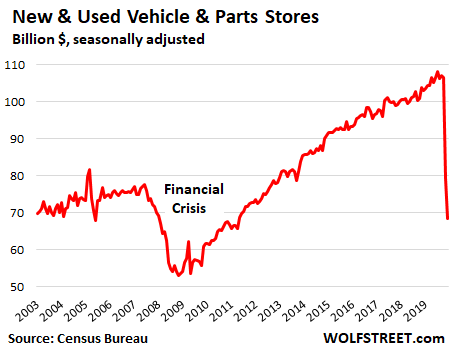
Sales at bars and restaurants collapsed by 30% in April from March, to $32 billion, the lowest since 2005, and were down 49% from April last year. Sit-down operations have largely been shut down, or have changed to take-out and delivery operations, which can keep at least some cash flowing. Most bars were closed. Other food services operations that weren’t relying on sit-down service, such as sandwich shops, are trying to wend their way through this, though lunch demand has plunged in many locations as people are working from home or have been laid off:
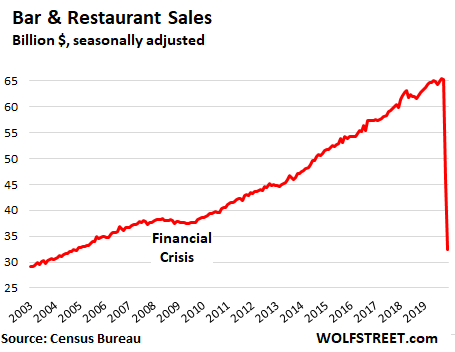
Sales at sporting goods, hobby, book and music stores plunged 38% in April from March and 49% year-over-year to just $3 billion. But even before Covid-19 hit, sales at these stores had been swooning. In 2019 and 2020 through February, sales were back where they’d first been in 2006:
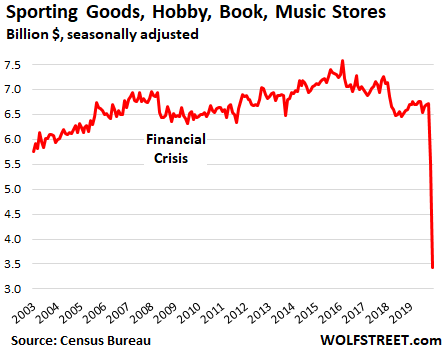
Sales at gas stations – which includes junk food and other stuff people buy at gas stations – plunged 29% in April from March and 43% from April last year, to $25 billion. This is a function of both, declining demand for gasoline as commuting has fallen off drastically, and the plunging price of gasoline at the pump. Sales at gas stations have now fallen below the low of the Financial Crisis and are back to 2003 levels:
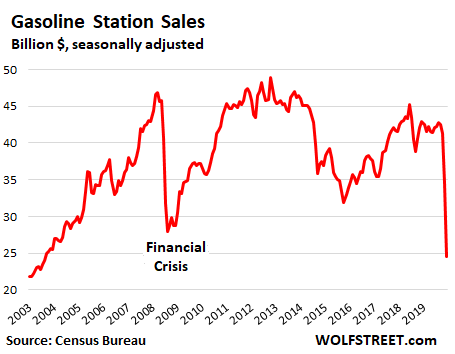
Sales at furniture and home furnishing stores collapsed by 59% in April from March and by 66% year-over-year, to just $3 billion:
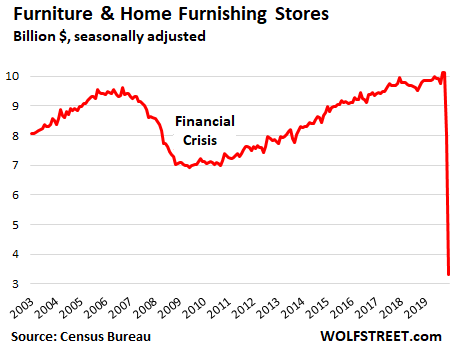
What we’re seeing here is how the Covid-19 crisis compressed the brick-and-mortar meltdown that has been going on for years into a much shorter time span. Many of these stores were already on the ropes, with their business model under relentless attack from ecommerce. And this crisis will cause many of them to shut down permanently now rather than a year or two from now.
And ecommerce was booming before Covid-19 and has suddenly taken on a new role and a new magnitude that often exceeded the capacity of the fulfillment infrastructure. Companies have spent billions of dollars every year building out their ecommerce infrastructure, but no one was prepared for this.